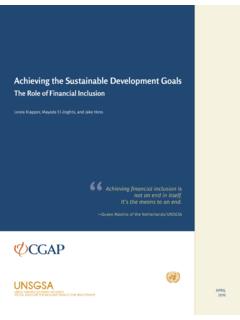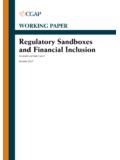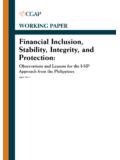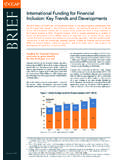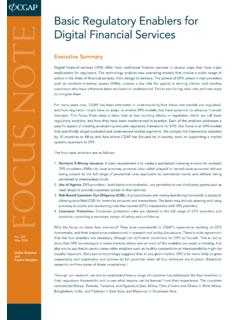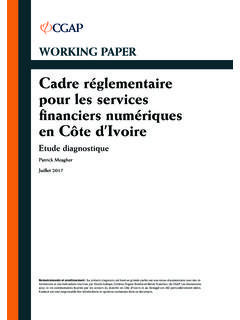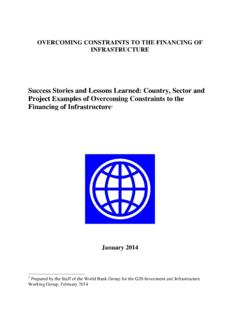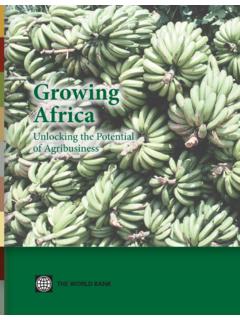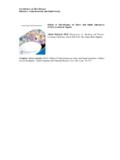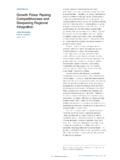Transcription of Development Finance Institutions and Financial …
1 Significant strides have been made in connecting the world s low-income populations and micro and small businesses to Financial services. Yet, after decades, there are still large gaps in access, use, product offering, and quality of services. Several segments remain overlooked ( , rural populations, women, ethnic minorities, smallholder families, specific business sectors, etc.). Many countries still struggle with undeveloped Financial systems even when excluded populations gain access to Financial products and services, many Financial offerings are poorly designed, understood, or used. In the past, Development actors assumed that access to capital was the main barrier to scaling Financial inclusion, but over time, local bank financing and savings mobilization have increased, and foreign funding continues to grow (including through microfinance investment vehicles [MIVs]) (Soursourian and Dashi 2016).
2 Other barriers that hinder Financial inclusion include, among others, deficient market infrastructure, limited technological innovations, and restrictive policy and regulatory s A Market Systems Approach to Financial Inclusion: Guidelines for Funders (Burjorjee and Scola 2015) encourages funders to take a market systems approach to Financial inclusion, arguing that only a more systemic approach can make a significant and sustainable contribution to Financial inclusion (see Box 1).1 Applying a market systems approach requires funders to understand the market system more deeply, taking into account the interplay of different market actors and the functions they perform (or fail to perform) in the system. Key functions in the market system for Financial services include demand, supply, supporting functions, and rules and norms (see Figure 1). The shortcomings of market systems are often deeply rooted in established practices and behavior of market actors, which are shaped by the information available to them, their capacity, and incentives.
3 These barriers are complex, making them more difficult to address than funding gaps. They require funders to address underlying problems that prevent markets from becoming more inclusive. Rather than strengthening individual market actors ( , Financial service providers [FSPs]), a systemic approach to Financial inclusion requires funders to set the right conditions for these actors to adopt new, more inclusive behaviors and to stimulate uptake of the new behaviors beyond initial partners and the duration of a funder s intervention. Systemic change occurs when market dynamics have changed sustainably and result in a more inclusive Financial services market. This approach requires being open to taking risk, being flexible, identifying new investment opportunities beyond FSPs, and having a willingness and ability to learn from for FSPs Is Not the Stumbling PointDFIs play an invaluable role in developing Financial markets and have been key to strengthening and building FSPs that serve low-income markets.
4 As seen in Figure 1, these FSPs are a niche supplier. DFIs Financial inclusion commitments are heavily concentrated on financing these retail FSPs (92 percent of commitments; see Figure 2), which helps to address FSPs funding constraints. When adding capacity-building grants to FSPs (4 percent), 96 percent of DFI commitments are dedicated to financing or strengthening the supply side in the Financial services market, and it is uncertain as to what extent other market barriers to Financial inclusion are addressed by DFIs Finance Institutions and Financial Inclusion: From Institution-Building to Market DevelopmentNo. 105 March 2017 Louise Moretto and Barbara ScolaFOCUS NOTE1 In this paper, market Development approach, systemic approach, and market systems approach are used interchangeably in referencing changes to the Financial services research suggests that DFIs can significantly increase their contribution to Financial inclusion by (i) expanding their lens to thoroughly review how their interventions affect the entire Financial system, (ii) growing their risk appetite to test new business models and delivery channels that help bring the poor into the Financial system, and (iii ) leveraging their technical credibility to facilitate market Effectively, DFIs would help drive a more sustainable and dynamic market that ultimately presents them with new and more diversified investment opportunities, eventually benefitting the private investors they seek to crowd into the market.
5 Several DFIs are considering broadening their scope of activities and realize that they may need to take more risks, but it is not clear how they will do a market systems approach would help DFIs frame their investment strategy within the broader context of market change and higher DFI additionality. Cambodia provides an early DFI example that preceded and resembles the modern day market systems Development approach. In Cambodia, a small group of coordinating DFIs and donors not only funded a promising microfinance institution (MFI) in a risky undeveloped market, but the group also advocated for policy and regulatory changes that ultimately created a robust microfinance industry. Further, the NGO became the country s largest commercial bank, serving many remote communities (70 percent of its portfolio is classified as rural), and expanding to two other Asian countries (see the following section, DFIs Deploying Elements of a Market Development Approach: Mini-Cases ).
6 This paper aims to show what a market systems approach could look like by highlighting cases of DFI contributions to market Development and by addressing the challenges and requirements DFIs face and ways they can influence broader market Interviews were an important component of our research and recommendations; more than 40 industry experts, including those working in DFIs and MFIs, consultants, and digital Finance experts, were interviewed. The paper promotes the idea that DFIs can and often should play an expanded role in promoting market Development beyond an investment-only approach ( , supporting policy and regulatory changes and providing advisory or technical assistance on critical market innovations). The market systems approach does 2 Technical credibility refers to many DFIs recognized expertise on Finance , banking, legal, and other private investment-related matters, including overlaps in policy and This paper discusses how DFIs pursued elements of a market Development approach to address needed changes in how a particular market was functioning.
7 It does not address how to measure the impact of market Development programs. (CGAP is working on a separate market systems measurement handbook, which will go deeper on this topic.)A market systems approach aims to catalyze systemic change change that is significant in scale and sustainable. The following are key features of a market systems approach: Consideration of the whole market system (not just the supply side). Overcoming barriers to Financial inclusion requires addressing underlying constraints in the market. The lack of providers serving low-income segments is often a symptom of underlying problems that might be linked to an unconducive policy environment, a lack of understanding of excluded segments, or misaligned incentives. Facilitative interventions. DFIs and other funders need to think of themselves as facilitators who encourage changes to incentives in the market system that enable a broad range of market actors to perform market functions more effectively.
8 Incentives and crowding-in. In theory, DFIs play a temporary role in markets and should work toward crowding in market actors, including private investors. Crowding-in often requires setting the right conditions ( , transparency) and incentives. Flexibility. Adopting a market systems approach requires working with a broader range of market actors and responding to dynamic changes in Financial markets. DFIs (and other funders) need to invest beyond prevailing business models; this requires flexibility and a higher level of risk-taking ( , innovator companies).Box 1. What is a market systems approach to Financial inclusion? And as it is applied to DFIs?See Burjorjee and Scola (2015).3not suggest that DFIs become more like donors (managing large grant programs) or that donors become more like DFIs (setting aside sizable amounts of their budget for investments). Their traditional and complementary roles remain intact, with the flexibility for different types of funders to participate in specific market initiatives where they have a comparative Role in Embracing a Market Systems ApproachInvesting in Development : Balancing Financial and developmental returnsDFIs mandate is to contribute to achieving Development goals through investments in private-sector companies that yield market or near market Financial returns.
9 Their mandate and instruments are complementary to bilateral and multilateral Development agencies that provide predominantly grants and loans to governments, and rarely work directly with the private sector. DFIs government shareholders expect DFI investments and interventions to have broad Development impact. DFIs typically aim to deliver broader Development impact beyond the direct outputs created by their investees including economic growth, inclusive markets, and improved policy However, DFIs face difficult trade-offs between Development and Financial returns and have been criticized for not sufficiently prioritizing Development outcomes (Savoy, Carter, and Lemma 2016). Incentivizing commercial investors to invest in projects with high potential Development impact is core to achieving a DFI s mandate, and can be realized when DFIs invest early in new business models or help develop new market AND NORMSC odes of conductInformal normsSupervisionRegulationsStandardsSUPP ORTING FUNCTIONSC oordinationInfrastructureSkills & capacityCapital marketsInformationFigure 1.
10 The market system and main market functionsNote: This diagram was adapted by CGAP from the Springfield Centre s Making Markets Work for the Poor (M4P) framework, commonly known as a market systems Development approach. The framework seeks to change the way markets work by addressing systemic constraints and engaging market actors to create large-scale, lasting benefits for the See Bortes, Sunil, and Grettve (2011).4 Additionality and catalytic are terms that are often used to describe the nature of DFI funding and the role it plays in market Development . DFI funding is considered additional when funds are invested in countries, sectors, regions, capital instruments, or business models where commercial investors have not (yet) invested (Savoy, Carter, and Lemma 2016). It is considered catalytic if it crowds in commercial investors, particularly local investors. Yet, both descriptions refer to DFIs only as providers of funding and understate the facilitating role DFIs can play as suggested in the DFI Financial inclusion approach to date: Investment driven to FSPsDFI funding for Financial inclusion has continually increased since 2007 when CGAP started collecting annual data on cross-border funding, with DFIs representing 42 percent of estimated cross-border Financial inclusion commitments globally as of December The average DFI commitment for Financial inclusion is $ million and has been relatively steady since 2013.
